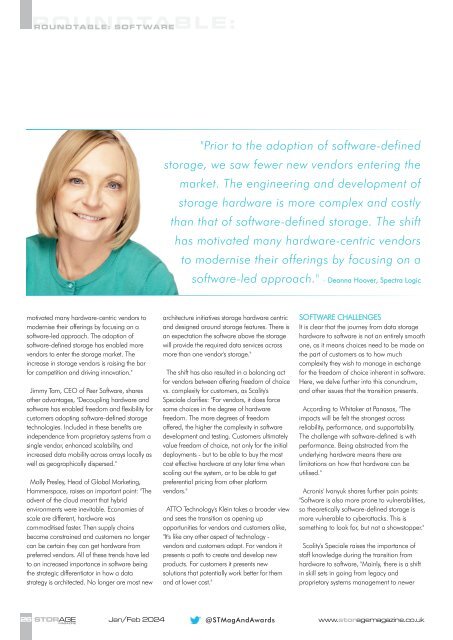ST2401
Create successful ePaper yourself
Turn your PDF publications into a flip-book with our unique Google optimized e-Paper software.
ROUNDTABLE: SOFTWARE<br />
"Prior to the adoption of software-defined<br />
storage, we saw fewer new vendors entering the<br />
market. The engineering and development of<br />
storage hardware is more complex and costly<br />
than that of software-defined storage. The shift<br />
has motivated many hardware-centric vendors<br />
to modernise their offerings by focusing on a<br />
software-led approach." - Deanna Hoover, Spectra Logic<br />
motivated many hardware-centric vendors to<br />
modernise their offerings by focusing on a<br />
software-led approach. The adoption of<br />
software-defined storage has enabled more<br />
vendors to enter the storage market. The<br />
increase in storage vendors is raising the bar<br />
for competition and driving innovation."<br />
Jimmy Tam, CEO of Peer Software, shares<br />
other advantages, "Decoupling hardware and<br />
software has enabled freedom and flexibility for<br />
customers adopting software-defined storage<br />
technologies. Included in these benefits are<br />
independence from proprietary systems from a<br />
single vendor, enhanced scalability, and<br />
increased data mobility across arrays locally as<br />
well as geographically dispersed."<br />
Molly Presley, Head of Global Marketing,<br />
Hammerspace, raises an important point: "The<br />
advent of the cloud meant that hybrid<br />
environments were inevitable. Economies of<br />
scale are different, hardware was<br />
commoditised faster. Then supply chains<br />
became constrained and customers no longer<br />
can be certain they can get hardware from<br />
preferred vendors. All of these trends have led<br />
to an increased importance in software being<br />
the strategic differentiator in how a data<br />
strategy is architected. No longer are most new<br />
architecture initiatives storage hardware centric<br />
and designed around storage features. There is<br />
an expectation the software above the storage<br />
will provide the required data services across<br />
more than one vendor's storage."<br />
The shift has also resulted in a balancing act<br />
for vendors between offering freedom of choice<br />
vs. complexity for customers, as Scality's<br />
Speciale clarifies: "For vendors, it does force<br />
some choices in the degree of hardware<br />
freedom. The more degrees of freedom<br />
offered, the higher the complexity in software<br />
development and testing. Customers ultimately<br />
value freedom of choice, not only for the initial<br />
deployments - but to be able to buy the most<br />
cost effective hardware at any later time when<br />
scaling out the system, or to be able to get<br />
preferential pricing from other platform<br />
vendors."<br />
ATTO Technology's Klein takes a broader view<br />
and sees the transition as opening up<br />
opportunities for vendors and customers alike,<br />
"It's like any other aspect of technology -<br />
vendors and customers adapt. For vendors it<br />
presents a path to create and develop new<br />
products. For customers it presents new<br />
solutions that potentially work better for them<br />
and at lower cost."<br />
SOFTWARE CHALLENGES<br />
It is clear that the journey from data storage<br />
hardware to software is not an entirely smooth<br />
one, as it means choices need to be made on<br />
the part of customers as to how much<br />
complexity they wish to manage in exchange<br />
for the freedom of choice inherent in software.<br />
Here, we delve further into this conundrum,<br />
and other issues that the transition presents.<br />
According to Whitaker at Panasas, "The<br />
impacts will be felt the strongest across<br />
reliability, performance, and supportability.<br />
The challenge with software-defined is with<br />
performance. Being abstracted from the<br />
underlying hardware means there are<br />
limitations on how that hardware can be<br />
utilised."<br />
Acronis' Ivanyuk shares further pain points:<br />
"Software is also more prone to vulnerabilities,<br />
so theoretically software-defined storage is<br />
more vulnerable to cyberattacks. This is<br />
something to look for, but not a showstopper."<br />
Scality's Speciale raises the importance of<br />
staff knowledge during the transition from<br />
hardware to software, "Mainly, there is a shift<br />
in skill sets in going from legacy and<br />
proprietary systems management to newer<br />
26 STORAGE Jan/Feb 2024<br />
@STMagAndAwards<br />
www.storagemagazine.co.uk<br />
MAGAZINE
















